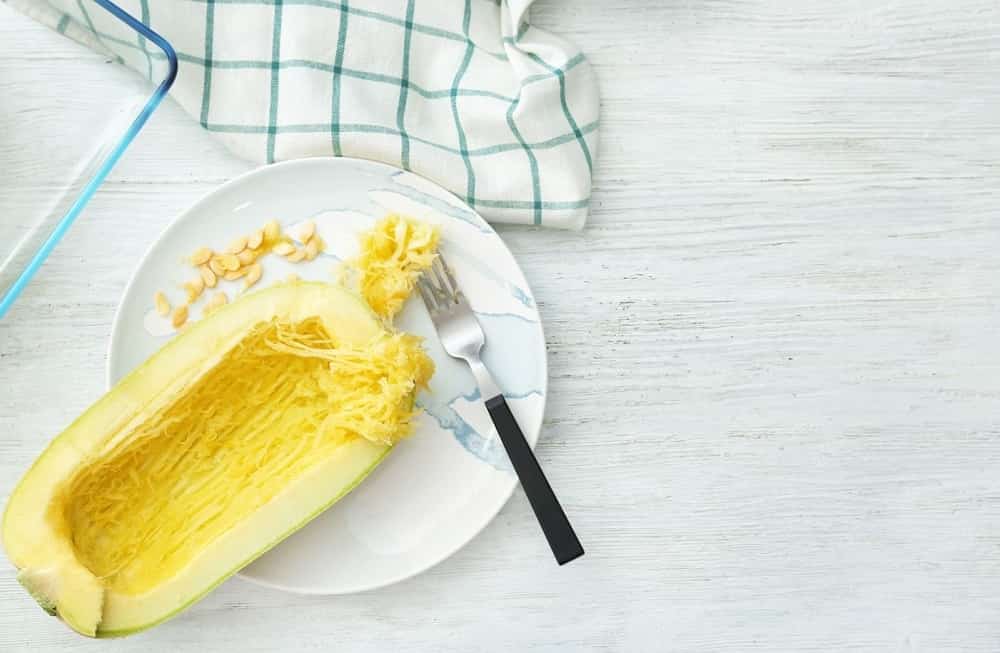Spaghetti squash is a versatile ingredient that can be used multiple ways.
It’s especially helpful in getting children to eat vegetables, as the squash is usually used as a spaghetti substitute, which is very nutritious.
Because it resembles pasta, you can trick those smaller fussy eaters into eating some of their greens, without having a screaming match or resorting to bribery.

It’s also a great alternative to pasta for those who can’t tolerate gluten, but want something like spaghetti (see also Freezing Spaghetti) without paying a lot for it.
The fruit itself is loaded with antioxidants, vital fats, minerals, and vitamins that help in creating a balanced diet. It also helps that it is fairly inexpensive.
Spaghetti squash is big enough that you may struggle to use it all in one go if you’re a smaller household.
You may also have a problem if not everyone likes spaghetti squash, leading to doubts whether you’ll actually manage to use it before it goes off.
As it takes a lot of time to prepare, the time-consuming process of preparing spaghetti squash may seem more effort than it’s worth.
Luckily, you can freeze it, making the preparation time that bit easier, and more attractive when you know you can actually use it when you want to.
Once it’s defrosted, you can just reheat it with your sauce of choice.
There’s a lot to know when it comes to spaghetti squash. The more you know about this versatile fruit, the better it will be when you come to enjoy it, and the better it will survive the freezing and thawing process.
What Is A Spaghetti Squash?
Spaghetti squash goes by a few names. It’s also referred to as noodle squash, vegetable spaghetti, spaghetti marrow (see also can you Freeze Zucchini?) or vegetable marrow.
The only difference between a spaghetti squash and a spaghetti marrow is the size (see also Can You Freeze Marrow?).
A marrow tends to be a much bigger version of a squash, and sometimes the flavor is a little weaker as a result.
Spaghetti squash is a variety of winter squash, related to the acorn and buttercup squash.
You can recognize a spaghetti squash by its oval shape, and yellow flesh on the inside. When you cook it, the flesh transforms into strands which look like noodles.
This doesn’t happen if you cut it into cubes before you cook it, though. You’ll need to cook it in halves if you want the flesh to fall away from the fruit like spaghetti.
The seeds inside a spaghetti squash are edible, and roasting them is a great way to eat them, further adding to the reasons why you should enjoy this versatile squash.
How To Tell The Difference Between Spaghetti Squash And Butternut Squash
Butternut squash and spaghetti squash are two different types of squash, and have different uses and flavors.
A butternut squash grows in a bell-shape, while a spaghetti squash is only oval. Both squashes come in different colors, but spaghetti squash is known for being a vivid yellow squash.
The flavor of a spaghetti squash is neutral, and the texture tends to be chewy and stringy.
When it comes to the flavor of butternut squash, it’s a lot sweeter than the spaghetti squash, and has a creamy consistency like mash (see also Freezing Butternut Squash Soup).
Butternut squash is usually orange rather than yellow, but this depends on the variety you choose, or what’s available.
Can You Freeze Spaghetti Squash?
Why You Shouldn’t Freeze Raw Spaghetti Squash
You can freeze spaghetti squash no problem, but the only real way to do it is by cooking it first.
Trying to freeze spaghetti squash raw means you’ll have to freeze it whole, and who has the room for that?
You might have a walk-in freezer (lucky for some), but that’s still not a reason why you should freeze it raw.
Freezing it raw means that you’ll still have to prepare it once you thaw it – and defrosting it will take an agonizing amount of time because the fruit is still whole.
It may even defrost unevenly, leading to a whole host of other problems.
Cutting up the raw spaghetti squash for freezing doesn’t work either, as it’ll lose a lot of flavor, and you won’t get that spaghetti texture.
Only fresh spaghetti squash for freezing.
Don’t be tempted to freeze leftover spaghetti squash that’s been sitting in the fridge for days, as this will most likely lead to food poisoning when you come to use it.
For best results, only freeze spaghetti squash that’s just gone completely cold.
How To Prepare Spaghetti Squash For Freezing

How To Choose The Right Spaghetti Squash
To get the best results when it comes to enjoying spaghetti squash in your favorite dish, you’ll need to select the freshest spaghetti squash you can.
This might seem counterproductive, but when it comes to freezing food, the fresher the food is to begin with, the better the results will be once you’re finished.
Make sure to go for a spaghetti squash that’s large and firm. Inspect the skin, making sure that there’s no insect damage, bruising, or discoloration.
While you could freeze a spaghetti squash that’s less than perfect, you’ll have to cut out the bad bits, so why not go for a whole one?
How To Cook Spaghetti Squash Before You Freeze It
First, you need to wash the spaghetti squash by rinsing it under the tap, making sure to get rid of any soil or anything else that shouldn’t be there.
Dry the squash thoroughly with either a dish towel or paper towels.
You’ll need to cut the fruit in half. If you don’t have very sharp knives, you can soften the squash by microwaving it for a couple of minutes.
First, make some holes on the outside with a fork, and put it into the microwave for no longer than 3 minutes, otherwise you may cook it before you want to.
If you skip the ventilation step, the squash will explode, leaving a horrible mess. We’ve all been there, but do we need to go there again?
You’ll also want to take the seeds out of the squash. You can dig them out with a tablespoon without much trouble.
Don’t forget, you can roast them for a tasty snack, just like you can with pumpkin seeds. Scoop out the seeds and save them for later, but make sure you cook them before you eat them!
The easiest way to cook the spaghetti squash is to cut it in half, deseed it, and put it into a roasting tin.
Drizzle some olive oil on top and prepare your favorite seasonings, and let the squash bake in a preheated 400°F oven for about an hour until the flesh becomes tender when you fork it.
If you prefer, you can dice it and then roast it, but this will mean the squash will lose its spaghetti texture.
You can also try cooking it in the microwave, but the texture will be altered, and it’s very easy to overcook it.
Once it’s tender, take the squash out of the oven or microwave, and let it cool completely.
How To Freeze Spaghetti Squash
Take a fork, and scrape the flesh out of the squash into a bowl. It should come away from the fruit easily.
Grab some heavy-duty freezer bags, and portion the spaghetti squash as necessary into the bags.
Squeeze out any excess air and seal the bags. Label with the freezer date, and freeze.
When stored this way, spaghetti squash can last up to a year.
Make sure you use the spaghetti squash within a few months, otherwise you’ll notice a significant drop in the texture, flavor, and maybe even a color change.
If you find that you forget about food in the freezer too often, make a habit of checking the freezer every few weeks to see what needs to be used up.
How To Defrost Spaghetti Squash
When you want to use the spaghetti squash, the best way to thaw it is to put it straight into the fridge.
Leave the spaghetti squash overnight to defrost completely, and by the time you come to use it, you’ll be able to reheat it straight away.
If you need it quicker, you can put the sealed freezer bag into a bowl of tap water, and this will help thaw the spaghetti squash within a few hours.
Why You Shouldn’t Refreeze Spaghetti Squash
Make sure to only defrost as much spaghetti squash as you need to prevent food waste, as it won’t last a second freezing session.
While the flavor and texture isn’t hugely affected by the freezing and thawing process the first time around, this doesn’t mean you can refreeze it.
Refreezing spaghetti squash will result in the texture breaking down. When you come to reheat the thawed spaghetti squash, you will probably find that it will turn into mush, especially if you put the heat too high, too quickly.
How To Reheat Thawed Spaghetti Squash
When it comes to reheating your thawed spaghetti squash, it’s worth keeping in mind that you’ve already cooked it, so be careful about overcooking it.
On The Hob
This is probably the best method of reheating spaghetti squash, though you will need to keep a close eye on it. Luckily, you won’t be babysitting the spaghetti squash for long.
You’ll need a saucepan that’s suitable for the amount of spaghetti squash you want to cook. Grab some pasta sauce, and put both the spaghetti squash and the sauce in the pan, on a medium heat.
Avoid putting the spaghetti squash straight into the pan with olive oil. This will fry it, and while that might be a nice option, it will no longer have the spaghetti texture.
Let both the spaghetti squash and the sauce heat through for 5 minutes. If you cook it for any longer than that, you risk the spaghetti squash losing its shape and turning to mush.
This is a very easy dish to make that also comes with a lot of nutritional value, as freezing the spaghetti squash will have preserved most of its vitamins and minerals.
It also has the added benefit of being a very cheap dish to make, especially if you make your own pasta sauce, freezing it into portions, and then taking it out as you need it.
In A Steamer
Like the hob method, putting spaghetti squash into a steamer will help heat it without the squash becoming dry or brittle.
You will need to make sure that the spaghetti squash is fully defrosted, as with the other methods, or it could fall apart in the steamer.
Simply put the spaghetti squash into the steamer, and let it cook for 5 minutes, or until hot enough.
Don’t cook it for too long, otherwise the structure of the squash will start to break down, and you’ll end up with mash instead of spaghetti.
Microwave It
If you need the spaghetti squash quickly, you can microwave it, but be careful not to overdo it, as this will render the spaghetti squash dry and or chewy and generally disappointing.
It doesn’t have to be entirely thawed for you to microwave it.
In fact, it’s probably best if it’s not fully defrosted, as there’s less chance of overcooking it, and it’s less likely to lose any more moisture content than it did when you froze it.
Put the squash into a dish that you can microwave, making sure to drizzle some oil on the top. Season as necessary, and partially cover it. Cook it on high for 30 seconds.
Stir the spaghetti squash and check it. Carry on heating it in small increments until it’s piping hot, making sure to stir it each time.
Is There A Difference In Flavor When It Comes To Defrosted And Fresh Spaghetti Squash?
This depends on how fresh the spaghetti squash was in the first place, how long it’s been in the freezer, and how you cooked it.
If you put off freezing the squash until the last minute, you will notice a difference.
This also goes for bruised or damaged spaghetti squash, which will never freeze as well as a perfect, fresh spaghetti squash.
Similarly, if you leave the spaghetti squash in the freezer for longer than a few months, this will also affect the taste and texture.
The squash may have lost some of its flavor, and the structure of the fruit may collapse part way through cooking, if it’s suffered some freezer burn or if reheated on a fierce heat.
If you cook your thawed spaghetti squash differently to how you’d cook a fresh one, then you will notice a difference, simply because you used a different method and the results were different.
If you’ve followed the tips in this article, making sure not to freeze the spaghetti squash before it has completely cooled, there’s no reason why you or anyone else should notice a difference.

Conclusion
Spaghetti squash is a very nutritious squash which is perfect for warming you up in the winter months.
It’s also a little more filling than traditional pasta, and it’s the perfect gluten-free alternative as it has a similar texture to egg-based pasta.
Spaghetti squash has one drawback when it comes to cooking it, and that’s the preparation involved.
When you’ve had a long day, the last thing you’ll probably want to do is to struggle with cutting a spaghetti squash, roasting it and then preparing the spaghetti squash pasta.
If you freeze the spaghetti squash once you’ve cooked it, you’re doing all the hard work ahead of time.
This means that you can simply take the spaghetti squash out of the freezer when you want it, and when it comes to cooking it, you’ll only need to spend about 5 minutes reheating it, without having the trade-off of eating something that’s less nutritious.
